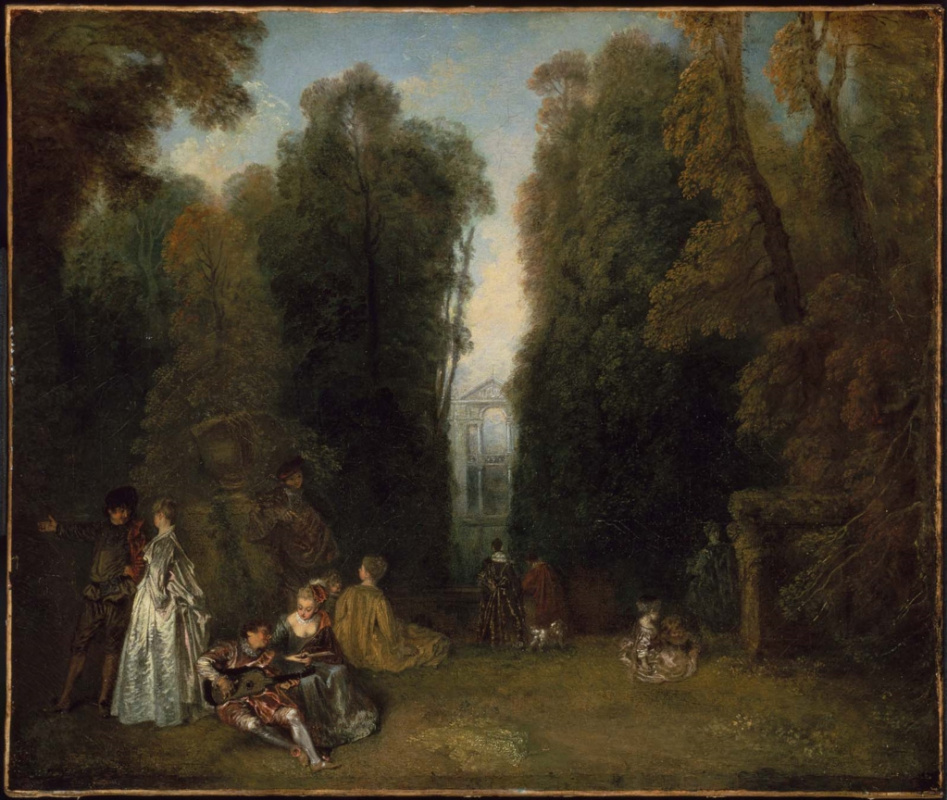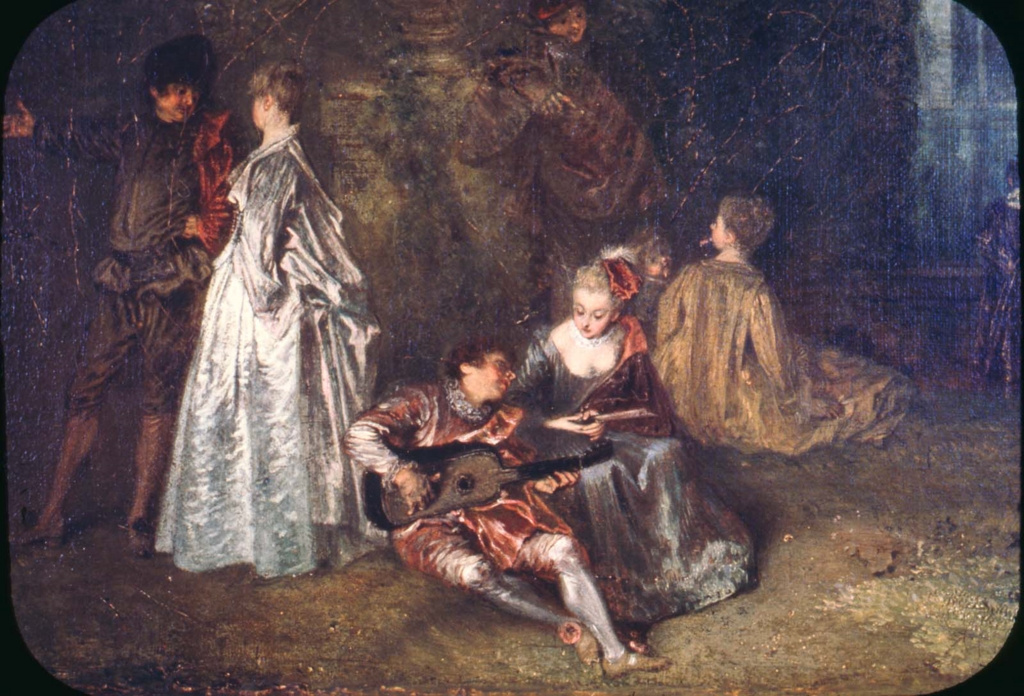log in
Enter site
Login to use Arthive functionality to the maximum
Perspective
Antoine Watteau • Painting, 1715, 46.7×55.3 cm
Description of the artwork «Perspective»
This painting by Antoine Watteau, stored now in the Boston Museum of fine arts, has the author's name, it was known as just "View". Or, alternatively, "Perspective".
Watteau was a kind man – he almost never signed their work and not invented for them names. The case of the artist's pencil and brush, and call pattern let the customers or connoisseurs of art. Before the last sweep more than once inadvertently put complex tasks. As, for example, to define a sort of "Perspective"? It is a landscape? Or group portrait? Or genre scenes? Neither the first nor the second, nor the third. The French Royal Academy, Watteau, taking in academics, received an extraordinary: especially for paintings by Watteau, she invented a new genre, unique. And called it fetes galantes, "gallant festivals".
The Boston "Look" – it is also a gallant feast.
Elegant and relaxed French aristocrats walk in nature, sweet talk, play, flirt. Beautiful nature and exquisite architecture that play up to them. But where is Antoine Watteau, the son of a roofer from the provincial town of Valenciennes, could it be observed?
Having achieved success in Paris, Watteau acquired influential patrons. Many of them thought of the artist, his close friend and even gave it to a private estate. One such person in my life Watteau was a millionaire Pierre Crozat. He was a "chief tax" in one of the French provinces and a real financial genius. However, mocking countrymen still called him "poor Crozat". Not because spared, and – to distinguish from the more wealthy Crozat, his brother. He lived in America and he almost single-handedly owned all of Louisiana, the fertile land downstream of the Mississippi. But "poor Crozat" is also not in poverty: bought works of art (by the way, his immense collection acquired by Catherine II, immediately put the Hermitage in one of the best museums of the world) and built castles in France. Watteau he was so sympathetic that she invited the artist to draw up a brilliant residence in Montmorency, but to live there on a guest.
The residence of Pierre Crozat at Montmorency we see in this picture. Life in the manor flew slowly, everything was organized to the delight and entertainment of the guests. Regularly held concerts, and home shows, attracting everyone to participate, could take several days. Those who have not been in the mood to act, wander in the Park. That's what we see in Watteau. The society was divided into couples. The gentleman in the left corner of the canvas pointing direction is likely to invite his lady to walk alone. Another couple of nice talks. Someone plays music. Someone deleted into perspective.
What is the main value of the picture? In the fact, that Watteau was so loved by the French is unmatched in the artist's ability to convey the atmosphere. Atmosphere of ease, idleness and hovering over all sadness. But why the sadness? About the heroes of Watteau's fair to say that they do not think about the future and live one day. This "stealing beauty" can not cause feelings of anxiety: everything is ephemeral, life is fleeting, no one can know – what's ahead. Drop-down prospect with a pediment surmounted by a white gazebo, melting in the fog only adds to this sense of mystery, of uncertainty.
By design, who designed the Park, the gazebo must be brought before the eyes of visitors immediately, she's half hidden behind the trees. There is something intriguing. And very typical for Watteau. The French very few people are able to admire as they are. They believe that Watteau brilliantly conveys the elegance of French lifestyle and way of thinking. But in the end a wonderful example of the latter: the brothers Goncourt in the "Outlook" Watteau was fascinated by not the composition or the color, and the fact that "the trees it looks like dance around people".
Author: Anna Yesterday
Watteau was a kind man – he almost never signed their work and not invented for them names. The case of the artist's pencil and brush, and call pattern let the customers or connoisseurs of art. Before the last sweep more than once inadvertently put complex tasks. As, for example, to define a sort of "Perspective"? It is a landscape? Or group portrait? Or genre scenes? Neither the first nor the second, nor the third. The French Royal Academy, Watteau, taking in academics, received an extraordinary: especially for paintings by Watteau, she invented a new genre, unique. And called it fetes galantes, "gallant festivals".
The Boston "Look" – it is also a gallant feast.
Elegant and relaxed French aristocrats walk in nature, sweet talk, play, flirt. Beautiful nature and exquisite architecture that play up to them. But where is Antoine Watteau, the son of a roofer from the provincial town of Valenciennes, could it be observed?
Having achieved success in Paris, Watteau acquired influential patrons. Many of them thought of the artist, his close friend and even gave it to a private estate. One such person in my life Watteau was a millionaire Pierre Crozat. He was a "chief tax" in one of the French provinces and a real financial genius. However, mocking countrymen still called him "poor Crozat". Not because spared, and – to distinguish from the more wealthy Crozat, his brother. He lived in America and he almost single-handedly owned all of Louisiana, the fertile land downstream of the Mississippi. But "poor Crozat" is also not in poverty: bought works of art (by the way, his immense collection acquired by Catherine II, immediately put the Hermitage in one of the best museums of the world) and built castles in France. Watteau he was so sympathetic that she invited the artist to draw up a brilliant residence in Montmorency, but to live there on a guest.
The residence of Pierre Crozat at Montmorency we see in this picture. Life in the manor flew slowly, everything was organized to the delight and entertainment of the guests. Regularly held concerts, and home shows, attracting everyone to participate, could take several days. Those who have not been in the mood to act, wander in the Park. That's what we see in Watteau. The society was divided into couples. The gentleman in the left corner of the canvas pointing direction is likely to invite his lady to walk alone. Another couple of nice talks. Someone plays music. Someone deleted into perspective.
What is the main value of the picture? In the fact, that Watteau was so loved by the French is unmatched in the artist's ability to convey the atmosphere. Atmosphere of ease, idleness and hovering over all sadness. But why the sadness? About the heroes of Watteau's fair to say that they do not think about the future and live one day. This "stealing beauty" can not cause feelings of anxiety: everything is ephemeral, life is fleeting, no one can know – what's ahead. Drop-down prospect with a pediment surmounted by a white gazebo, melting in the fog only adds to this sense of mystery, of uncertainty.
By design, who designed the Park, the gazebo must be brought before the eyes of visitors immediately, she's half hidden behind the trees. There is something intriguing. And very typical for Watteau. The French very few people are able to admire as they are. They believe that Watteau brilliantly conveys the elegance of French lifestyle and way of thinking. But in the end a wonderful example of the latter: the brothers Goncourt in the "Outlook" Watteau was fascinated by not the composition or the color, and the fact that "the trees it looks like dance around people".
Author: Anna Yesterday





